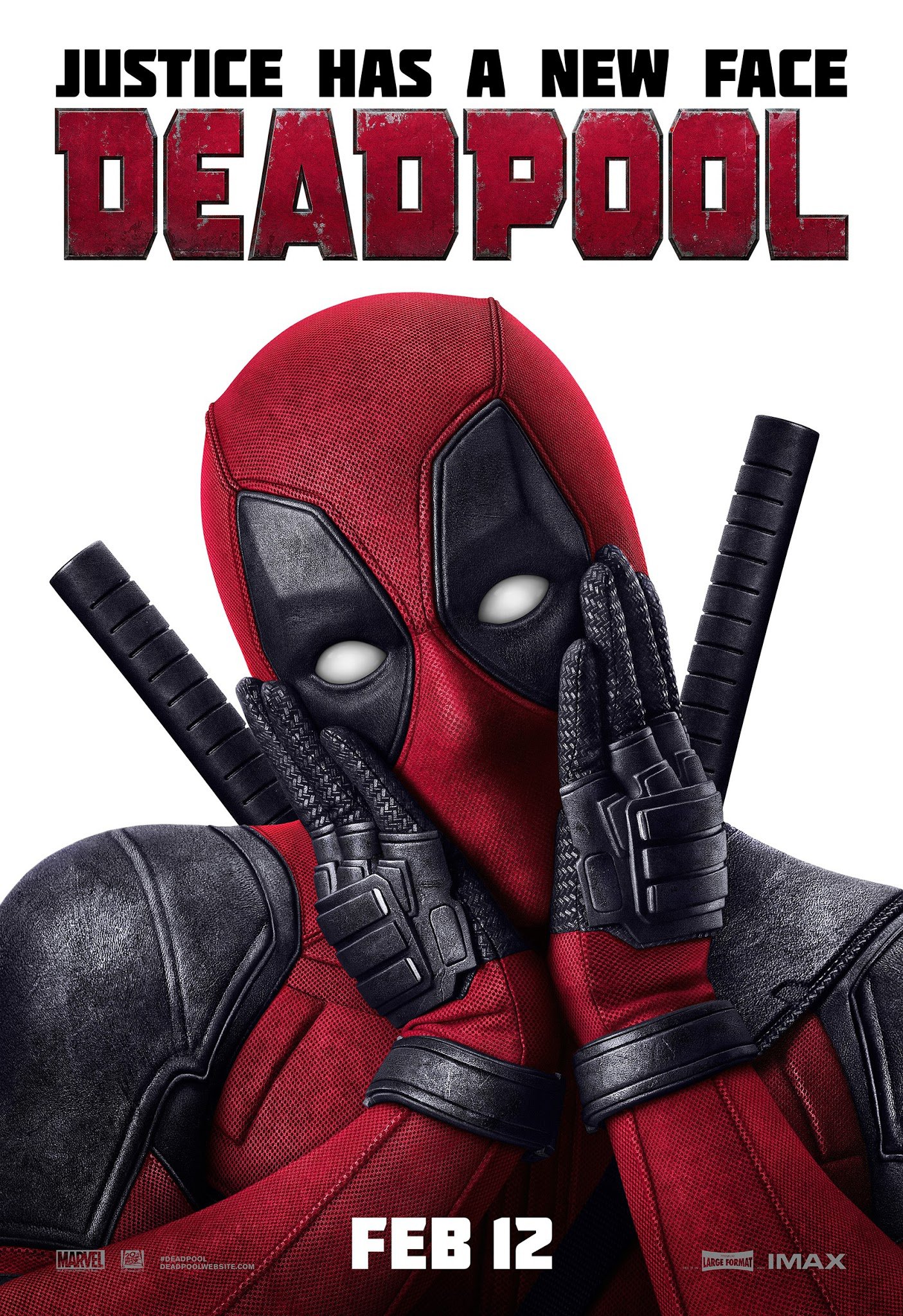Hello there, welcome to another issue of Morning Coffee.
This week we’re going to take a break from Star Wars, and focus on the latest family-friendly movie to arrive at theaters worldwide: Deadpool.1
Deadpool is a fun movie. A really, really fun movie. However, it’s not for the faint of heart. It’s full of bad language, sex, violence, blood, and generally speaking, everything that’s wrong with humans as a species. As fun as it is to watch, this is not a nice movie.
Beyond that, though, what interests me most about the film is the story behind its production, and what its commercial success could mean for the filmmaking industry as a whole.
Don’t worry, this entire issue is spoiler-free, so you can keep reading even if you still haven’t watched the movie. But seriously, what are you waiting for? It’s really good.

Issue #34: A different kind of superhero movie
Deadpool is not your typical superhero. He’s a foul-mouthed, amoral character that is not beyond killing to get what he needs — or just for the fun of it, really. He is definitely not your typical Marvel superhero, and couldn’t be farther from the watered-down depictions of Marvel characters that we’ve seen in movie adaptations so far.
The problem is, those decaffeinated adaptations have been breaking box office records year after year after year, so who’s ever going to dare argue that they’re doing it wrong?
Conventional movie-making wisdom says that PG-13 movies are much more likely to be a hit at the box office than R-rated movies. Therefore, it’s perfectly understandable that big Hollywood studios like Disney — the rights owner for most Marvel characters — would be adamant in their use of PG-13 ratings for these types of films.
There’s a very good case to be made that superhero movies need to be family-friendly. I get that, but the problems it presents as far as storytelling and consistency go are significant. While it’s technically possible to depict a hostile alien invasion that destroys half of Manhattan and crushes entire buildings without showing so much as one innocent person dying in the process, it’s hard to argue that it is a very realistic approach.
I’m not saying they need to show dead bodies and blood just for the sake of it, mind you. On the contrary. There are plenty of great storylines in Marvel’s rich history that would allow screenwriters to come up with interesting plots without having to rely on apocalyptic scenarios for dramatic effect.
However, for better or worse, it looks like the recent trend towards darker, more mature superheroes in comic movie adaptations that began with Christopher Nolan’s Batman trilogy is here to stay. And Marvel has been trying — however mildly — to give their own heroes the same gritty vibe, all while refusing to give up their prized PG-13 rating.
In my opinion, something has to give. There are only so many alien or robot armies you can conjure up for the good guys to fight without making it look like they’re killing people. As long as they continue to pursue those darker storylines but refuse to own up to their consequences, Marvel movies will continue to exist in that weird, undefined space that the PG-13 rating represents. Creatively speaking, it’s the worst of both worlds.
The biggest problem, however, is not that a movie refuses to embrace darkness when it is not a driving part of the plot. Disney and Marvel have every right to keep telling superhero stories in a way that is accessible for younger audiences, and those movies will keep being made. Maybe they’ll get over that gritty phase and return to more normal storylines, or maybe they won’t, but that’s not a huge deal in and of itself.
The real problem is when a movie that clearly needs to be R-rated gets watered down in such a way that its essence gets compromised, just for the sake of having a better shot at the box office. That’s what happens when bureaucrats and accountants take control of film studios, and it’s a very serious problem that’s been going on for decades in Hollywood. When these businessmen have so much power and influence that they can effectively exert creative control over a film’s production, you have a recipe for disaster.
Sometimes, a movie calls for an R rating. For example, the original Terminator film was a dark, terrifying story about a nearly indestructible killing machine, and fit the R rating like a glove. Its much-lauded sequel, Terminator 2, was another masterpiece in horror moviemaking, and once again, made extremely good use of its R rating.
However, by the time Terminator 3 rolled around, with its newly-revised PG-13 rating, things started taking a turn for the worse, as the story became more about chases, explosions and robot fights than about the sheer psychological horror of knowing an unstoppable machine is trying to squeeze the life out of you with its cold metal hands. And with just a brief look at the latest mess in the franchise’s troubled history, it’s easy to understand why sometimes, a PG-13 rating just won’t do.
To sum things up: the two R-rated Terminator films are classics, while every other film in the franchise has been mostly forgettable. Coincidence? I think not.
Enter Deadpool, perhaps the one Marvel character that could put this ratings assumption to the test.2 Clearly, Deadpool as a character can only work in an R-rated movie. He needs to do all sorts of grossly inappropriate things on screen that are not only there for the audience’s amusement, but because they are the essence of the character. That’s who Deadpool is, and showing him in a different light would make no sense whatsoever. I know that because we’ve already seen it, and we’re all still trying very, very hard to forget about it.
It’s no surprise, then, that Deadpool is a movie that almost didn’t get made.
Ryan Reynolds, the actor who plays the title character, had been trying to get Fox to greenlight the film for over a decade, only to be given vague promises and uncertain propositions. His only non-negotiable request was that the movie would be R-rated, which turned out to be a significant hurdle in the negotiations. Unsurprisingly, the project was put on ice several times over the years, until Reynolds took matters into his own hands.
Once he had a script, he convinced Fox to let him shoot some test footage, which was then “accidentally” leaked online, prompting many Deadpool fans all over the world to flood Fox with requests to get the film made. Eventually the studio caved and greenlit the movie, albeit with a rather conservative $58 million budget, no doubt as a result of the studio’s doubts on whether the movie could be a commercial success.
How ironic, then, that Deadpool has turned in the biggest opening weekend ever for an R-rated movie — beating 2003’s The Matrix Reloaded — and also the biggest opening weekend ever for Fox as a whole — beating 2005’s Star Wars: Episode III, and all films in the X-Men franchise, including 2014’s Days of Future Past. If this doesn’t prove that an R-rated movie can still be a commercial success, nothing will.
There’s nothing wrong with PG-13 movies, but sometimes, an R rating is necessary to tell a story. If Deadpool’s biggest accomplishment is to be the film that convinces studios to once again give these stories a chance to be properly told, it will have been well worth it.
In the meantime, we can all find some comfort in watching the merc with a mouth on the big screen, just like we always wanted: irresponsible, irreverent, violent, and lots and lots of fun.
Now, let’s take a look at some of the week’s most interesting pieces of writing.
♢
Top Five: The Jedi Council and the Supreme Court, a visit to the end of the world, and the history of malt liquor
Some really interesting pieces in this week’s roundup. And now without further ado, let’s get to it.
Lessons for the Supreme Court from the Jedi Council | Adam Gopnik →
Terrific essay over at The New Yorker:
In the “Star Wars” realm, various reasons have been produced for this weird amnesia, though the actual reason is obviously that George Lucas hadn’t entirely figured out the backstory when he wrote that first movie, or known that he’d ever be held so tightly accountable for its details. And then, when he did work that Jedi Council into the prequels, some twenty years after the first movie was released, it turned out to be the most grossly inept rubber-masked gang in the history of high-minded quangos. You could practically be wearing a T-shirt that says, “Hello, I am a Sith Lord,” and they wouldn’t sniff the dark force coming from your armpits. A rational person would conclude that, despite their own relentless self-promotion of their extra-rational, hyper-reasoning, instinctive sense—their communion with the Force!—this was not in fact a council into which you should put a lot of confidence. That distant galaxy seems to have an undue cultural investment in the wisdom of the Jedi Council, even in the face of its ineptitude.
It looks silly and humorous at first, but there’s quite a bit of depth to it, too.
♤
A brief visit to the end of the world | David Cain →
David Cain does it again:
I realize this sounds morbid. We don’t like to think about the end of the world. But that’s why we probably should, occasionally but deliberately. We are so attached to civilization, stability, and freedom that we don’t want to even imagine life without them. For that reason, we stop noticing these huge, essential pieces of our happiness, and we fill our heads with worries about the state of the smallest pieces—missed appointments, insensitive comments, and other day-to-day ephemera that probably won’t matter a month from now.
The Peacetime Dream is the holy grail of backdrops for a human life, and it is a peculiar tragedy that we still aren’t great at finding happiness in it. Ironically, what would perhaps help us most is to look out at our neighborhoods and picture what they might be like as ruins.
♧
The sleazy and spectacular history of malt liquor | Dave Infante →
Fascinating story:
And it all started with malt liquor. To Vultaggio, malt liquor was a good business proposition. Serving the underserved. Getting product to market. In the years that followed, malt liquor came to represent a lot more, to a lot more people, in a hell of a lot more places. Since its creation, malt liquor’s fortunes have been entangled with America’s sorest social bugbears, from race, to class, to poverty, to whether or not capitalism ought to give a shit about any of those things.
Maybe you’re familiar with its baggage. Maybe not. As Kihm Winship (who wrote one of the few good histories of malt liquor) put it, it is “a story without heroes.” But what a story. Thanks to the people who made it, sold it, protested against it, rapped about it, and of course drank it, the history of malt liquor is a spectacular and uniquely American shitshow. And here it is, in all its glory.
♡
Finding good content | Ben Brooks →
Ben Brooks wrote a thought-provoking piece on why we continue to support sites that clearly have no respect for our time, and wonders if there’s a way out:
That’s what we used to do. We used to vote with our attention and then at some point we stopped caring and decided it wasn’t the job of the media to determine what matters, it’s our job to wade through it. So instead of media outlets hiring smart people who can distill complicated subjects, they just started hiring people who could write somewhat passable sentences and a lot of barely passable sentences in a day.
We have a name for this: we call it 24/7 cable news — but it applies to everything, even blogs. Especially blogs.
I agree with Ben about the importance of changing this dynamic. He proposes AI as a likely way forward, and though I’m not so sure about that — I believe human curation and great editorial teams are must-haves for any serious publication — I would be willing to give it a try and see where it leads us. It can’t be any worse than the current situation, so there’s that.
♢
Review: Zeiss Loxia 21mm f/2.8 Distagon T* | Jordan Steele →
Jordan Steele delivers high praise for the latest lens in the Loxia family:
However, if you are fine shooting with primes for ultra-wide work (and especially if you love the 21mm focal length), then there’s no need to look any further. The Loxia 21mm is truly exceptional, and supplants the Fuji 14mm as the finest wide-angle lens I’ve had the pleasure to use.
I’m not really comfortable shooting at the ultra-wide angle end, but even I have to admit this is clearly the most interesting Loxia lens so far.
♤
Afterword
What a week.
In case you missed it, my in-depth review of the Sony FE 70-200mm F4 lens was published on Tuesday over at Tools and Toys.
If that wasn’t enough, on Wednesday I made my podcasting debut, alongside Marius Masalar and Josh Ginter. Candid is a weekly photography show that explores the skills and technology we contend with on the road from hobbyist to professional. Each episode is roughly an hour, and it has a casual, relaxed tone that I really enjoy.

Working on the show with Marius and Josh has been a treat so far, and we’re all having tons of fun with it. Hopefully you will, too. And if you decide to listen and like what you hear, please take a minute of your time to spread the word, and review the show on iTunes. It really helps us a lot. Thanks!
We’re now working hard on the second episode of the show, and we’d love to have you along for the ride. And of course, if you have any feedback, we’d love to know about it.
Have a great weekend, and as always, thank you for reading.
